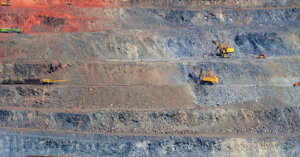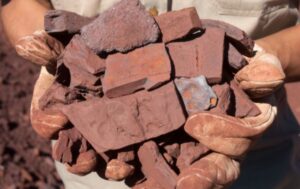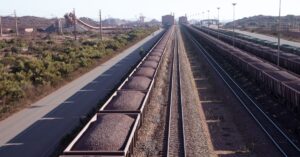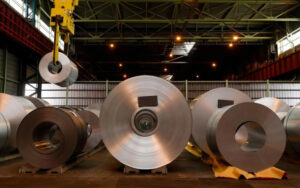
In January-May this year, Ukrainian mining companies reduced exports of iron ore in physical terms by 12.8% year-on-year to 13 million 545,967 thousand tons from 15 million 542,428 thousand tons.
According to the statistics released by the State Customs Service on Friday, during this period, foreign exchange earnings from the export of iron ore decreased by 21.5% to $1 billion 73.888 million from $1 billion 367.161 million.
Exports of iron ore were carried out mainly to China (44.98% of supplies in monetary terms), Slovakia (17.17%) and Poland (16.65%).
In addition, in January-May 2025, Ukraine imported iron ore worth $46 thousand in the amount of 65 tons from the Netherlands (46.67%), Norway (28.89%) and Italy (24.44%), while in the same period last year it imported 303 tons worth $121 thousand.
As reported, in 2024, Ukraine increased exports of iron ore by 89.8% compared to 2023 – up to 33 million 699.722 thousand tons, while foreign exchange earnings increased by 58.7% to UAH 2 billion 803.223 million.
In 2024, Ukraine imported iron ore worth $414 thousand in a total volume of 2,042 thousand tons, while in 2023, 250 tons of this raw material were imported for $135 thousand.
In 2023, Ukraine decreased exports of iron ore in physical terms by 26% compared to 2022 – to 17 million 753.165 thousand tons. Foreign exchange earnings amounted to $1 billion 766.906 million (down 39.3%). The company imported iron ore for $135 thousand, totaling 250 tons.

In January-March this year, Ukrainian mining companies reduced exports of iron ore by 5.7% in physical terms compared to the same period last year, to 8 million 492.479 thousand tons.
According to the statistics released by the State Customs Service on Tuesday, foreign exchange earnings from iron ore exports decreased by 20.3% to $687.788 million during this period.
Exports of iron ore were carried out mainly to China (46.46% of supplies in monetary terms), Poland (16.05%) and Slovakia (16.14%).
In January-March 2025, Ukraine imported iron ore worth $24 thousand in the amount of 43 tons from Norway (54.17%) and Italy (45.83%), while in the same period last year it imported 245 tons worth $67 thousand.
As reported, in 2024, Ukraine increased its exports of iron ore by 89.8% compared to 2023 – up to 33 million 699.722 thousand tons, while foreign exchange earnings increased by 58.7% to UAH 2 billion 803.223 million.
In 2024, Ukraine imported iron ore for $414 thousand in a total volume of 2,042 thousand tons, while in 2023, 250 tons of this raw material were imported for $135 thousand.
In 2023, Ukraine decreased exports of iron ore in physical terms by 26% compared to 2022 – to 17 million 753.165 thousand tons, foreign exchange earnings from iron ore exports amounted to $1 billion 766.906 million (down 39.3%). In 2023, Ukraine imported iron ore worth $135 thousand in a total volume of 250 tons.

In January-February of this year, Ukrainian mining companies reduced exports of iron ore in physical terms by 1.2% compared to the same period last year, to 5 million 595.706 thousand tons.
According to the statistics released by the State Customs Service on Tuesday, foreign exchange earnings from iron ore exports decreased by 18.7% to $449.388 million during this period.
Exports of iron ore were carried out mainly to China (46.50% of supplies in monetary terms), Poland (17.35%) and Slovakia (14.31%).
In January-February 2025, Ukraine imported iron ore worth $1 thousand in the amount of 5 tons from Italy.
As reported, in 2024, Ukraine increased its exports of iron ore by 89.8% compared to 2023 – up to 33 million 699.722 thousand tons, while foreign exchange earnings increased by 58.7% to UAH 2 billion 803.223 million.
In 2024, Ukraine imported iron ore for $414 thousand in a total volume of 2,042 thousand tons, while in 2023, 250 tons of this raw material were imported for $135 thousand.
In 2023, Ukraine decreased exports of iron ore in physical terms by 26% compared to 2022 – to 17 million 753.165 thousand tons, foreign exchange earnings from iron ore exports amounted to $1 billion 766.906 million (down 39.3%). In 2023, Ukraine imported iron ore worth $135 thousand in a total volume of 250 tons.

In January-February of this year, Ukrainian mining companies reduced exports of iron ore in physical terms by 1.2% compared to the same period last year, to 5 million 595.706 thousand tons.
According to the statistics released by the State Customs Service on Tuesday, foreign exchange earnings from iron ore exports decreased by 18.7% to $449.388 million during this period.
Exports of iron ore were carried out mainly to China (46.50% of supplies in monetary terms), Poland (17.35%) and Slovakia (14.31%).
In January-February 2025, Ukraine imported iron ore worth $1 thousand in the amount of 5 tons from Italy.
As reported, in 2024, Ukraine increased its exports of iron ore by 89.8% compared to 2023 – up to 33 million 699.722 thousand tons, while foreign exchange earnings increased by 58.7% to UAH 2 billion 803.223 million.
In 2024, Ukraine imported iron ore for $414 thousand in a total volume of 2,042 thousand tons, while in 2023, 250 tons of this raw material were imported for $135 thousand.
In 2023, Ukraine decreased exports of iron ore in physical terms by 26% compared to 2022 – to 17 million 753.165 thousand tons, foreign exchange earnings from iron ore exports amounted to $1 billion 766.906 million
(down 39.3%). In 2023, Ukraine imported iron ore worth $135 thousand in a total volume of 250 tons.

In 2024, Metinvest Mining and Metallurgical Group significantly increased its total exports and sales of iron ore to more than 12 million tons and significantly reduced production costs, Metinvest CEO Yuriy Ryzhenkov said in an interview with Forbes Ukraine.
“We have fully returned to the operational efficiency improvement program. For example, we have reconfigured our business process to use our own raw materials. And by most indicators, I mean technical, technological, and production ones, we have returned to the best results of 2020-2021,” the CEO stated.
According to him, the main disadvantage is the electricity outage and problems with its import. Another problem is the increase in tariffs for the services of natural monopolists, primarily the increase in electricity transportation tariffs and logistics. In addition, the aggressor’s offensive towards Pokrovsk. As a result, the group was forced to suspend the mine’s operations due to the inability to ensure electricity supply and safety factors for employees.
“We were preparing for this and diversified our supply chain for the same coal – we contracted as much as we could from other companies and shipped it for Ukraine’s needs from our plant in the US. We will definitely not stop steel production because of the temporary shutdown of the Pokrovsk mine. But it will have a serious impact on the company’s economy. Instead of supplying coal via the nearest logistics route, from Pokrovsk to Zaporizhzhia and Kamianske, we will now have to buy coal all over the world, and the logistics component will have a significant impact on our production costs. In general, up to 10% of the cost of coal,” said the CEO.
Answering a question about Donald Trump’s economic policy and expectations for the consequences for the global economy, Ryzhenkov explained that “it is not really known which initiatives of Donald Trump are serious and which are working to raise rates or invite to a dialogue.”
“We see tumultuous actions that make waves in the entire global economy, currencies, and so on. How will it all end? When a major power like the United States turns to protectionism, it is a serious problem for the global economy and, by the way, for the United States itself. It’s just that they will feel the consequences later – in three to four years,” the top manager predicts.
In turn, he noted that Metinvest’s deliveries to the US are insignificant – not even within the margin of error: “The largest share is pig iron, which is not subject to duty, and I think this will not change – it is the raw material for the American economy.”
Speaking about staffing issues, the CEO said that more than 20% of the group’s employees, or 30% of those liable for military service, are currently mobilized. Ryzhenkov believes that we need a normal, well-thought-out reservation system that will allow us to work. Reservations are not a privilege for business, as some say, but an integral part of preserving the economic basis of the state’s defense capability. If the economy does not work, Ukraine will lose the war, despite the support of the West.
As for the export strategy, it has not changed much compared to the period before the full-scale war.
“There are our key markets – Ukraine, the EU countries, where we supplied more than 50% of our products before the full-scale invasion. And then there are all the others, the so-called balance markets, which are characterized by a more opportunistic approach to supply. When it’s profitable for us, we go there, and when it’s not profitable, we don’t go there,” the CEO stated.
The Group’s key markets for iron ore are the EU countries. And the company has expanded them, entering Scandinavia and the Nordic countries. What we cannot sell in the EU due to limited consumption volumes is sold to Southeast Asia: China, South Korea, and so on, said the company’s CEO.
“The main thing we have focused on is the production of iron ore with a higher iron content, which is now in demand. We have already mastered its production at our joint venture, Pivdennyi GOK. Before the full-scale invasion, we did it at our Central GOK,” explained the CEO.
Regarding the forecast – what factors will have the greatest impact on exports in 2025 and what are the potential critical risks – Ryzhenkov divides them into several blocks. The first is to maintain the competitiveness of Ukrainian producers in foreign markets. This requires that state-owned monopolies do not create additional tariff pressure on operating businesses.
The second is maintaining access to foreign markets (it is important to preserve the liberalization of steel trade with the EU, the US, and the UK) and strengthening sanctions against the Russian metals and mining industry, which continues to sell slabs and pig iron to the EU because of the position of certain countries.
The third is a consistent environmental and industrial policy of the state on eco-modernization and decarbonization. Ukraine needs a delay in the CBA because of the war. And confirming the criticality of booking and engaging veterans in the workforce will remain a relevant factor because of the risk of losing qualified personnel.
“As for new challenges, it is access to financing for modernization and green transition projects in the mining and metals sector, as well as ensuring stable demand for Ukrainian steel in the domestic market. But these topics are post-war, and we can talk about them separately when peace comes,” the expert believes.
Speaking about the energy independence of Metinvest’s enterprises, the CEO said that the group has its own generation, about 45-50 MW, which provides the most critical processes – about 10% of the company’s energy consumption. Another 40 MW of gas-fired generation is under construction, which will be commissioned in 2025, and solar panels are also being installed.
Regarding investments, the CEO emphasized that due to security risks, the company cannot invest in Ukraine as before. There were serious investment plans in Mariupol, Kryvyi Rih, Zaporizhzhia, and Kamianske. Nevertheless, in 2024, the total investment volume reached about $670 million at the group’s sites in Ukraine. This includes both OPEX and CAPEX. As soon as the company is able to attract financing, there will be plans for large projects.
This year, we also have many plans, for example, a tailings pulp thickening project at Northern GOK and the repair of blast furnace No. 9 at Kametstal are being implemented at our own expense. The volume of investments in these projects in Ukraine alone is about $50 million.
Investment plans abroad include the largest project for the coming years – the construction of a green steel plant in Italy. The estimated cost of the joint project is EUR 2.5 billion.
Among other potential acquisitions, the company is interested in Eastern and Southern Europe – regions where it is possible to create synergies with the group’s existing business processes and Ukrainian assets. The company may take part in a tender for the sale of the Polish plant Huta Chestochowa, which once belonged to the Industrial Union of Donbass.
“In Ukraine, we have a $8 billion strategy for the green modernization of Ukrainian enterprises for 7-10 years. We are ready to launch this strategy as soon as the war is over and Ukraine receives security guarantees,” Ryzhenkov added.
“Metinvest is a vertically integrated group of steel and mining companies. The group’s enterprises are mainly located in Donetsk, Luhansk, Zaporizhzhia and Dnipro regions. The main shareholders of the holding are SCM Group (71.24%) and Smart Holding (23.76%), which jointly manage it.
Metinvest Holding LLC is the management company of Metinvest Group.

“Metinvest, Ukraine’s largest mining and metals holding, increased steel production by 4% year-on-year to 2.099 million tons in 2024.
According to the press release of the parent company Metinvest B.V. on its operating results for 2024, the production of total iron ore products increased by 42% to 15.733 million tons.
At the same time, the production of commercial iron ore increased by 58% to 14.826 million tons.
It is noted that capacity utilization in Ukraine was affected by factors such as security, personnel, electricity, logistics and economic factors.
Coke production in 2024 decreased by 10% to 1.122 million tons.
At the same time, Metinvest increased its total pellet production by 14% to 6.022 million tons, but reduced its total coking coal concentrate output by 22% to 4.277 million tons.
It is specified that in the fourth quarter of 2024, pig iron production at Kametstal decreased by 6% quarter-on-quarter to 452 thousand tons, mainly due to a short maintenance shutdown of blast furnace No. 9 in October. Crude steel production decreased by 14% quarter-on-quarter to 489 kt, driven by a shift in orders from finished products to commercial pig iron.
In 2024, pig iron production amounted to 1.818 million tons, up 3% year-on-year, thanks to the efficient operation of two blast furnaces. As a result, crude steel production increased by 4% year-on-year to 2,099 thousand tons.
In the fourth quarter of 2024, the production of semi-finished products amounted to 235 thousand tons (-6% q-o-q). Last year, the production of semi-finished products increased by 3% compared to 2023 to 861 thousand tons due to an increase in orders.
In the fourth quarter of 2024, production of finished products decreased by 2% quarter-on-quarter to 481 thousand tonnes, with flat products production increasing by 4% to 193 thousand tonnes due to an increase in hot-rolled plate production at Ferriera Valsider (Italy). Long products production fell by 6% to 288 thousand tonnes, mainly due to a reduction in the order book at Promet Steel (Bulgaria).
In 2024, production of finished products decreased by 6% to 2,159 thousand tons. In particular, flat products production fell by 16% to 922 thousand tons due to unfavorable European market conditions, especially the availability of cheaper Russian plates. This resulted in a lack of profitable orders for hot-rolled coils and a reduced order book for hot-rolled plates, the company said. At the same time, production of galvanized cold-rolled steel increased by 42% due to the resumption of inductor No. 4 at Unisteel in Ukraine after it was shut down for overhaul in the second quarter of 2023.
Long products production increased by 4% to 1,237 thousand tons, mainly due to a larger order book at Kamet Steel. Since February 2024, Russian troops have focused their efforts on several areas, including Pokrovske, close to Pokrovskugol. As a result, production there was suspended in December 2024.
In the fourth quarter of 2024, the Group’s production of coking coal concentrate decreased by 7% quarter-on-quarter to 1,057 thousand tons. The main factor was a 14% drop in production at Pokrovskugol to 566 thousand tons. At the same time, coal concentrate production at United Coal (USA) increased by 3% quarter-on-quarter to 491 thousand tons.
In 2024, the Group’s production of coking coal concentrate decreased primarily due to a 22% decline in production at Pokrovskugol to 2,426 thousand tons, mainly due to changes in geological conditions and events at the end of 2024. Coking coal concentrate output at United Coal decreased by 21% to 1,852 thousand tons due to downtime at Carter Roag and lower production at some Wellmore mines in 2023.
“Metinvest is a group of steel and mining companies located in Ukraine, Europe and the United States.
Its major shareholders are SCM Group (71.24%) and Smart Holding (23.76%), which jointly manage it.
Metinvest Holding LLC is the management company of Metinvest Group.